I could have mixed up Mr. Boston’s Champagne Julep from 1935 as it was written but where would be the fun in that?
The oldest Champagne Julep I uncovered from Hon WM (Cocktail) Boothby’s 1908 ‘The World’s Drinks and How to Mix Them’ was too hilarious not to try. As soon as I read the details of “the costliest drink made” I knew this one had to be on my drinking bucket list.
Rather than try and explain the Champagne Julep, I decided to let Mr. “Cocktail” describe this drink recipe in his own words:
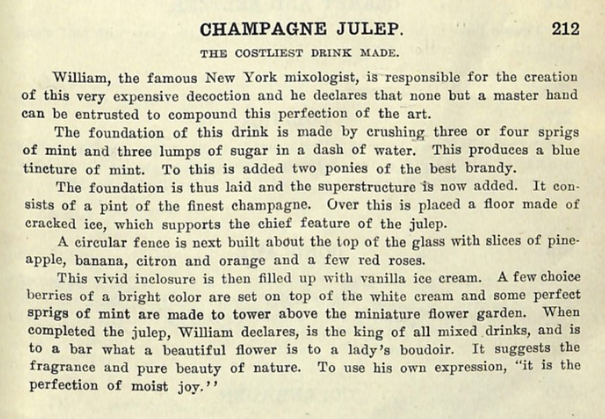

The World’s Drinks and How to Mix Them Champagne Julep Recipe 1908
Some details are conveniently missing from this very detailed cocktail recipe which brings up a heap of questions… Up first, what the heck is a blue tincture of mint?
The last time I made up a tincture of mint, it turned a muddy greenish brown as the chlorophyll leached into the alcohol. Many things could describe the color but blue is not one of them. I wondered if Mr. Boothby may have been color blind but I couldn’t find any proof that those who have color blindness confuse brown with blue.
In my quest for answers, I wondered if there were indeed a type of mint that produced blue leaves. While my search left me empty handed, I realized that many common culinary herbs i.e. basil, sage, thyme etc. are members of the mint family. Could this recipe be using an ingredient that is not in line with our modern idea of mint?
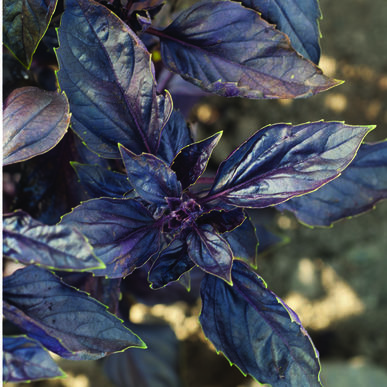

The closest I could find for an editable blue leaved plant in the mint family was this Red Rubin Basil. It errors on the purple side of the spectrum but was the truest blue leaf I discovered. Maybe this was what Mr. Boothby was calling mint?
Further down the recipe, we are instructed to add “two ponies of the best brandy” followed by the “superstructure” of the“finest champagne.” The brandy, mint and sugar provide the “foundation” of the cocktail – Sounds like I’m building a skyscraper rather than a drink – LOL!
It is unclear what the “best” and “finest” ingredients may have been circa 1908 but, for the sake of my budget, our best bottle of Symbole National XO and finest bottle of Barefoot Bubbly will have to do.
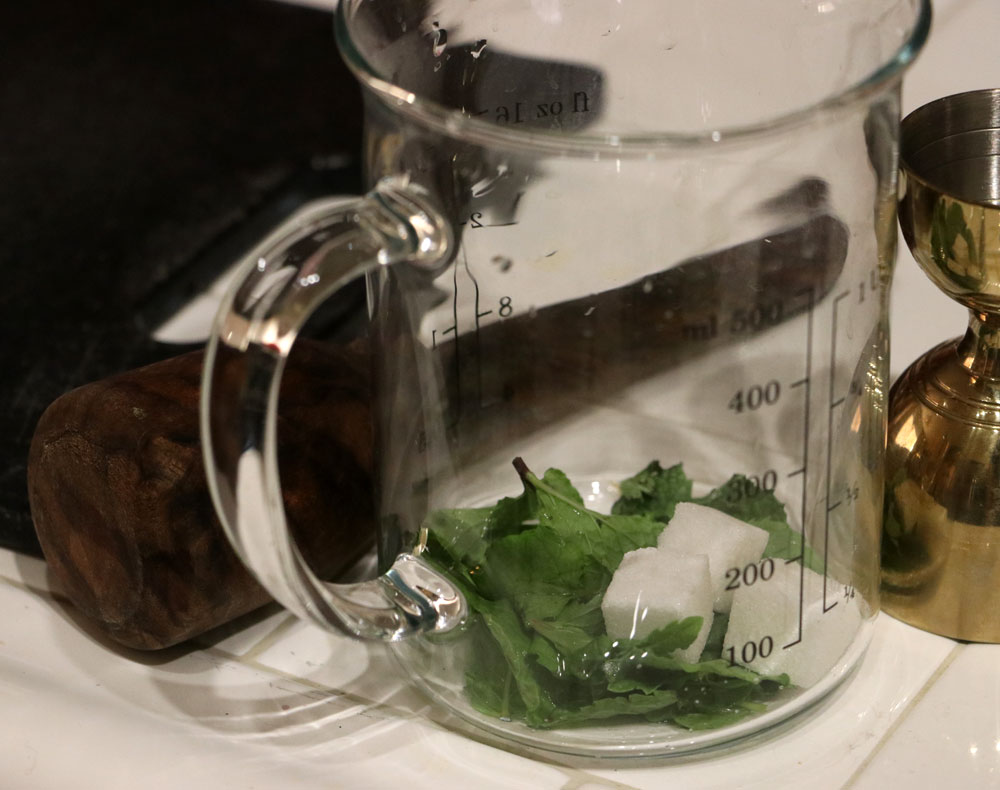

The largest vintage glasses I had were not large enough to fit the whole recipe so we made two instead and mixed the mint, sugar and booze together in a separate vessel.
So… this recipe clearly notes that a pint of Champagne is required. A pint by today’s measurements is 16 fluid ounces. By that measure, tonight’s cocktail is built for more than one. More over, I was not sure what vessel I had in the house to craft such a large cocktail into.
Finding the right drink ware would take some digging through boxes that had been sealed since our southerly move more than three years ago. Since our house is rather short on storage, I did my best to only disturb the items I thought would get the job done.
In brainstorming what type of glass may have been required for the early 1900 recipe, I realized that the presentation (mainly the size and addition of bubbly) was very similar to the Scorpion Bowl. Like Trader Vic’s Tiki favorite, the Champagne Julep incorporates spirits followed by sparkling wine and served in a highly decorative fashion. Alas, I don’t currently own a Scorpion Bowl and decided this beautiful rose colored goblet my great-grandmother left me would do the trick.
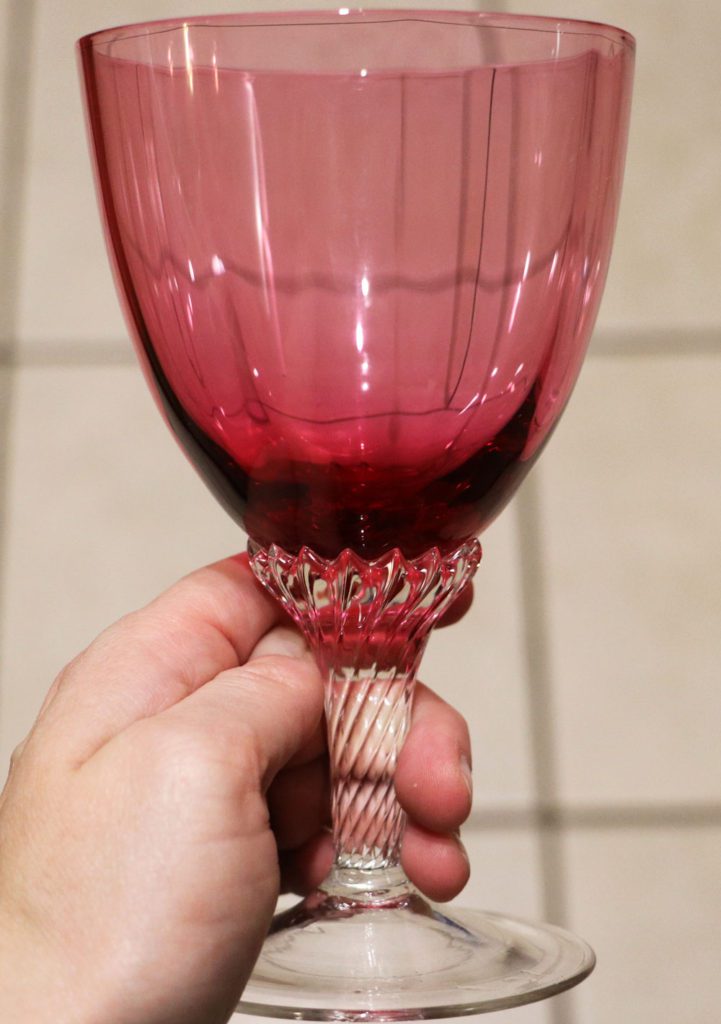

Of all the ingredients called for in this 1908 Champagne Julep, it is the garnish that both threw me into a fit of laughter and stole my heart. Who could possibly resist a cocktail that is a boozy ice cream sundae complete with a fruit fence and red rose garden?! It sounded deliciously bizarre and perfect for a night catching up on the latest episode of Game of Thrones.
Ryan joked that the garnish is the reason this was known as the costliest drink made. I suppose it did require a special trip to the grocery store for ice cream, fruit and flowers 🙂 The trip totaled $15 in goodies all for this one drink and not including the alcohol.
I’m not known for being the most patient people when it comes to embellishing culinary pieces. I can do it but it isn’t always me strongest talent. Ryan insisted on taking the lead in decorating the Champagne Julep and I let him have the task. I’m much better at supervising anyway (at least I think so – wink!)
While the recipe above is pretty specific that the circular fence along the top of the glass be built after the julep drink had been crafted, Ryan thought it would be better if the fence was assembled first. I however thought that the drink should be first, followed by ice, ice cream and finally the garnish. Seemed to me that the fruit was in danger of floating away if the Julep was not properly encased in shaved ice first. Female logic prevailed with protest.
Our Champagne Julep took roughly 35 minutes from start to finish. In taking so long, the final drink started to melt before the ice cream went on top. Once the frozen ball was added, the drink spilled over the sides of the glass and we frantically tried slurping it off the tray with straws. It was a pretty funny site!
Perhaps the trickiest part of this whole cocktail is trying to find a way to drink the darn thing. First we tried a straw, despite none being mentioned in the recipe. The ice clogged up the tube and proved useless. Next Ryan ate his way down to the ice capped top and tried to sip from the exposed side. His nose got creamed in the process.
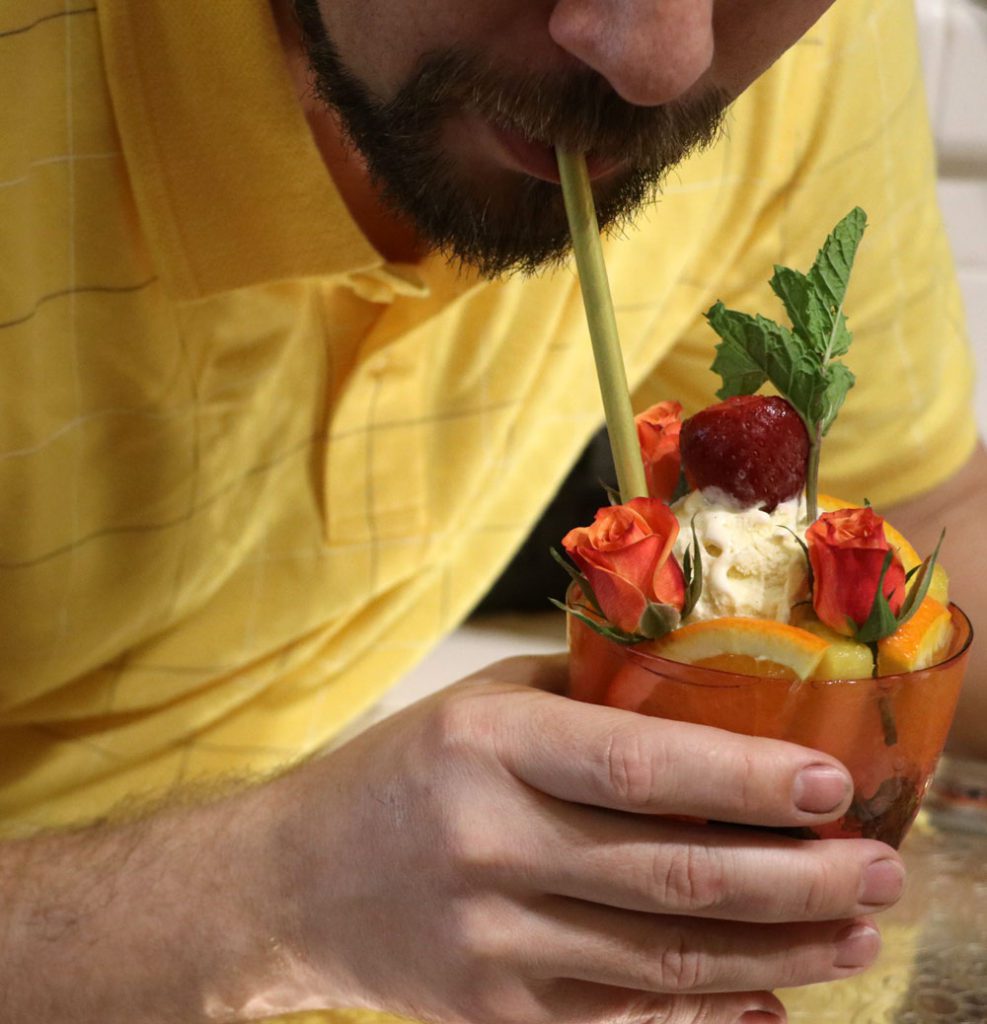

In case you were wondering, sipping champagne from a straw makes for rough drinking!
To taste, I thought that the Julep portion of the cocktail could have been sweetened up. Maybe our Brut was too dry? I think a bubbly Moscato would have been better instead. I think the Champagne Julep is all flair with little flavor. Having to add so much ice to hold the editable garden dilutes the drink. For me, the best part was the ice cream making this a fun desert but not a great cocktail.

